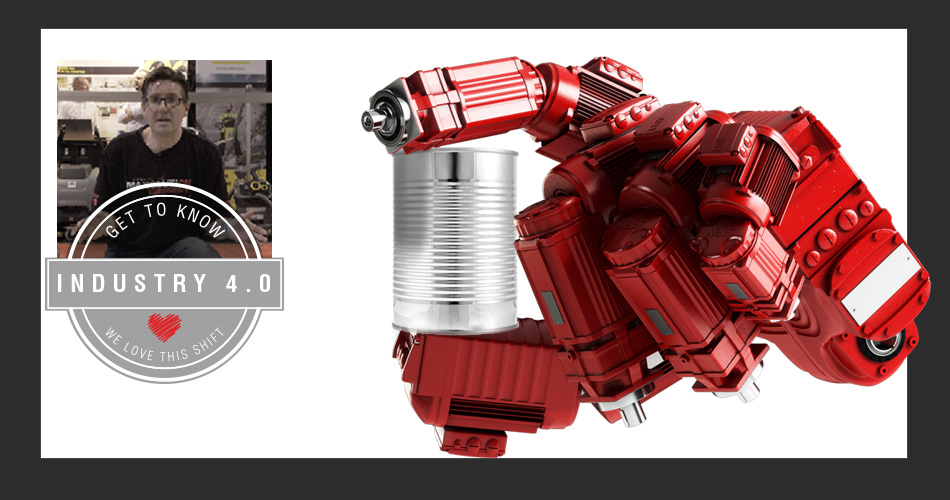MEET LYALL

- Lyall Watson
- Sales Manager - SEW-Eurodrive Canada
- E-mail Lyall
- Telephone: 905.791.1553
- Industry Core Competencies
- Bio
- Articles
Industry Core Competencies
- Automotive
- Food & Beverage
- Logistics
- Mining
- Industrial
- Motion Control
Lyall's Profile:
Spearheading the MAXOLUTION® initiative, Lyall is responsible for the direction of all system solutions development. His philosophy is to merge SEW-EURODRIVE’s knowledge and resources into an ultra-efficient, centralized management system that streamlines the project workflow and enforces the fundamental promise of delivering quality, and the benefits of SEW-EURODRIVE built right in. “Every solution we design, build, and start-up comes with our 85 years of experience and the post-sales support to back it up. The MAXOLUTION® branch brings together our core competencies and allows us the privilege of working even closer with our clients. Our real value has always been the intangible benefits that accompany every component that leaves our warehouse, this proposition has solidified our stake in the drive component space, and has led us to where we are today. MAXOLUTION® embraces those same principals, which ultimately means we`ve earned the trust of our clients. Whether you are an existing client that expects nothing less than the commitment to quality you already know, or a company actively sourcing a system solutions provider, I welcome the opportunity to showcase MAXOLUTION® System Solutions.
Contact Lyall
ARTICLES
MAXOLUTION®
Can Industry 4.0 help with defective rates caused by human errors?
The manufacturing process involves several steps to produce goods. One missed step, one error, one bad batch of outsourced ingredients, or one overlooked detail can cost a company millions of dollars and devastate its brand. Think of how many times we hear about car recalls or food being pulled from grocery shelves. What is the cost associated with this, and how does this happen? One avoidable cause is human error.

Have you ever assembled a flat-packed piece of furniture—let’s say a desk—and took a step back to marvel at your ingenuity, ready to pat yourself on the back, only to realize that a panel was facing the wrong way? Or better yet, looked down at the bag of hardware and asked yourself why you have extra parts? Of course you have. Why? Because you are human, and mistakes happen. As humans, we are born with emotions, and our minds wander; we have good days and bad days. All of this can distract us from our work.
The reasons for messing up are limitless: maybe the kids were screaming, or the dog used the instructions as a chew toy. Regardless of the reasons, something went wrong.
Manufacturers deal with these types of problems daily—hopefully, no kids or dogs are involved—but on a much grander scale. One missed step, a single overlooked detail, or a bad batch of outsourced ingredients can cost a company millions of dollars and wipe out its trusted brand. Think of how many times we hear about car recalls or food being pulled from grocery shelves. These recalls can lead to lawsuits and bankruptcies and set brand loyalty back decades.
One avoidable cause is human error. So what’s the fix? Let’s go back and imagine building that same desk, but this time, your mini home assembly plant was equipped with some Industry 4.0 technology. The hammer, the screwdriver, and even some of the parts had built-in sensors that would alert you to any errors or steps missed during the building process. And amazingly, the tools and parts were intelligent enough to correct the mistakes while you were building the desk, not afterwards. This would be much better than step-by-step online videos. Although Industry 4.0 at home isn’t quite here yet, it’s here for manufacturers.
A considerable part of Industry 4.0 is the integration of smart application using big data and the Industrial Internet of Things. New manufacturing systems have real-time communication gateways built into the equipment. The benefits of having access to play-by-play data transfers between applications and products mean human operators, engineers, and systems planners can analyze system performance and critical product information during the production process rather than after. The results aim to improve efficiency, quality, safety, and, ultimately, the bottom line. Despite the belief that robots and computers will eliminate certain jobs—which is still debatable—we know that Industry 4.0 is poised to improve the products we consume and contribute to a workplace that benefits everyone.
Stay in the loop, follow us on social media, or register below.
MAXOLUTION®
How Can Industry 4.0 Technology Reduce Accidents and Injuries?
For manufacturers, one of the benefits of adopting Industry 4.0 technology is a dramatically reduced number of accidents and injuries in their factories. Accidents and injuries are a huge problem in today’s manufacturing industry. Annually, thousands of people are injured in factories in Canada and around the world, costing hundreds of millions of dollars in treatments, rehabilitation, and downtime. Manufacturers who have adopted Industry 4.0 technology have learned that technology can reduce the number of accidents and injuries to zero.
IIIot sensors track environmental conditions and send instant alerts
The Industrial Internet of Things (IIIot) is a major component of Industry 4.0. It makes it possible for everyday objects to communicate with one another and with humans by sending and receiving information. In factories, IIIot sensors (i.e., sensors fitted with computer chips) can be embedded in tools and machinery. These IIot sensors continually track the tool or machine’s environmental conditions, such temperature, pressure, and vibrations. Whenever a value jumps up or below its prescribed parameter, the sensor sends instant alerts to the human supervisor via his or her smartphone, tablet or computer. Thus, managers can take immediate actions to prevent disasters.
Robots assist in performing all the dangerous and risky tasks
Like IIot, robots are a major component of Industry 4.0. With advancements in artificial intelligence and motion technology, they are becoming increasingly like humans. While most robots used in factories are designed to perform routine and precision tasks, there are advanced robots that can assist humans to perform a complex task that requires decision making. Human workers can use these robots as assistants to perform all the dangerous and risky tasks in factories. This eliminates accidents, such as falling from a great height, getting trapped between machines, inhaling toxic gas, and/or catching fire.
Automated Guided Vehicles (AGVs) are used to move heavy loads
Factory workers are often required to move heavy loads from one location to another in a manufacturing facility. This exposes them to risks of tripping, falling, and being hit by heavy objects daily. Factories can avoid these risks by using automated guided vehicles (AGVs), which are portable robots that navigate by following markers or wires placed on the factory floor. Some of the more advanced AGVs even use vision, lasers or magnets to find their way. Using AGVs eliminates the chances of accidents related to moving heavy materials.
Biomedical sensors send instant alerts about workers’ physicals processes
In a factory, workers are often exposed to extreme environmental conditions, such as an abnormally hot room or a place with high toxicity. Often, failing to pull them out just in time results in injuries and fatalities. In a smart factory, such risks are minimized by making a worker wear biomedical sensors. These sensors constantly track his or her physical processes, such as his or her heart and breathing rates, and send instant alerts to the supervisor if the values cross the threshold of safety. The supervisor can then pull him or her out immediately. Some smart factories require workers to always wear biomedical sensors during the working hours so their health can be constantly monitored.
Augmented Reality (AR) can be used in safety training
Safety training is essential for educating workers on how to keep themselves out of harm’s way. Augmented Reality (AR) can take safety training to the next level. Augmented reality (AR) is similar in concept to virtual reality (VR), but it is more real. In the latter, the user enters a totally virtual world by wearing a visor. In AR, a computer-generated 3-D-animated map of an object is superimposed on the object viewed through a computer screen, smartphone or tablet. The 3-D-animated map is accompanied by labels, instructions, and tips so trainees can get all the information they need without having to refer to their manual.
Thus, Internet 4.0 technology can be used very effectively to reduce accidents and injuries in factories.
MAXOLUTION®
The function of an AGV equipped with a conveyor application.
Lyall explains the function of an AGV equipped with a conveyor application. An ideal solution for shipping departments.
Our AGVs are designed to integrate into your existing motion plans and work with your applications. This quick example demonstrates how an AGV can be utilized with a conveyor for packaged goods. Investing in any new equipment can be a little intimidating, especially if it’s a new technology, and the manufacturer is in a different continent.
SEW’s MAXOLUTION division is in full swing right here in Canada. So, if AGVs, smart factory and Industry 4.0 are words popping up in your meetings, we’d love the opportunity to showcase our solutions, products and coast to coast support.
MAXOLUTION®
key Cost-Saving Benefits of Industry 4.0 to the Manufacturer.
Studies done in the United States, Canada, and other countries have shown Industry 4.0 comes with several cost-savings benefits for companies which directly improves the working conditions of its employees. We have compiled a list of the key cost-savings benefits to the manufacturer
What are some of the Cost-Saving Benefits of Industry 4.0 to the Manufacturer?
Often called the Fourth Industrial Revolution, Industry 4.0 technologies enable businesses to create smart factories that are more efficient, more productive, more flexible and more responsive to the customers. But, many manufacturers balk at the imaginary costs and complexity of introducing them in their factories. Also, the disinformation campaign by people who are afraid that robots will replace humans has made many workers hostile to them.
Robots can work 24/7
One of the major components of Industry 4.0 are industrial robots. While they are not as smart as humans and do not have the capability to make critical decisions, they can perform high-precision tasks without a glitch and also work 24/7 without a break, which is something that cannot be said about human workers. They also do not get hurt and do not take sick days. This means the factory will be operating nonstop throughout the year. The latest and most advanced robots can make job-specific decisions, which means less human intervention. Thus, using Industry 4.0 can greatly save costs.
Improved product quality
Traditional factories lose a lot of money on returned substandard products. Using Industry 4.0 can reduce or eliminate those costs. Real-time monitoring and quality control allow data to be collected from every point of production. This helps determine and control the conditions that affect the quality of products while production is in process, for example, determining the optimum temperature and pressure levels ensures the best quality and helps eliminate waste. This can help reduce or eliminate defective or substandard products, which means fewer products are returned for failing to meet specifications.
Reduced accidents and injuries
Accidents and injuries cost manufacturers a lot of money every year. Most accidents happen because of negligence, human errors, and defective equipment. In a smart factory, robots do all the dirty and dangerous jobs while humans monitor them from a safe distance. Robots do not get hurt — at least not in the way humans do. Damaged robots do not need to be hospitalized; they can be quickly repaired and put back to work. Severely damaged robots can be replaced with new robots. They need no financial compensation. There will be no costly medical bills and lawsuits. Thus, companies can save a lot of money by using Industry 4.0 technologies.
Reduced Operating Costs
All manufacturing companies want to reduce operating costs for the simple reason that lower operating costs mean higher profits. Industry 4.0 technologies make that possible without having to lay off workers and implementing any drastic cost-cutting measures. Real-time monitoring and quality control help reduce waste. Waste is a big problem in many traditional factories. Predictive maintenance prevents costly repairs and downtimes. Automation saves labor costs, increases production, and ensures quality. All these combine to reduce operating costs.
Higher competitive advantage
Industry 4.0 technologies provide businesses with a competitive advantage over companies that have not adopted them. Smart factories can operate 24/7. Robots and automation handle all the precision work. Real-time monitoring and quality control ensure higher product quality and reduced errors, and critical decisions are made without wasting time. From receiving orders to shipping products, the entire process is automated, which means a smaller workload, faster fulfillment, and increased customer satisfaction. All these translate into reduced costs.
MAXOLUTION®
POST SALES AND SUPPORT
MAXOLUTION® is about maximizing benefits for our clients. When we say “we’re all in” we mean it! Our commitment to is not only about selling one-off system solutions, but it’s also about fostering meaningful, long-term relationships with our clients well past the installation date
Regardless of what product or solution leaves our facility, know that Our Complete Drive Maintenance, (CDS®) plan will always be available to keep your uptime up, and your downtime down
MAXOLUTION
AGV BENEFITS
Lyall chats about the benefits of integrating Automated Guided Vehicles (AGV’s) into an assembly line. He also touches on some of the emerging industry 4.0 shifts occurring in the workplace. The Smart Factory does not only consist of adding AGV’s in the mix, it is a manufacturing philosophy the combines and utilizes cutting-edge technologies designed to improve the efficiency, management, and quality of the produced goods. MORE ON INDUSTRY 4.0

In Canada, many of our customers are corporately








